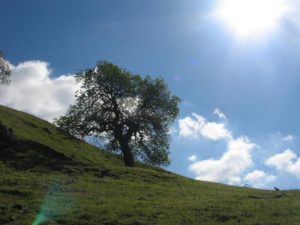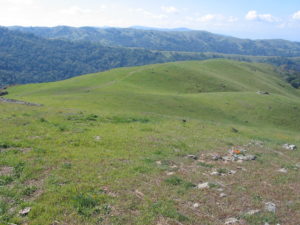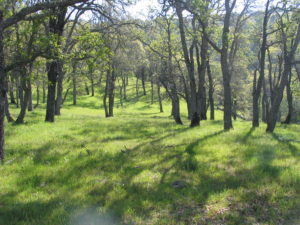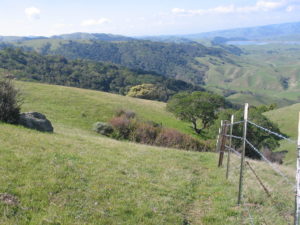



Area: 640 acres
Location: Near the City of Livermore, County of Alameda
Date Acquired: 2016
Acquisition Type: CNLM holds a conservation easement to protect the imperiled species and their Habitats on the preserve. The preserve is owned and managed by a private landowner.
Key Habitats: Annual grassland, Blue oak woodland, Coastal oak woodland, Chamise redshank chaparral and Coastal scrub.
Species of Special Interest to CNLM: California red-legged frog (Rana aurora draytonii), California tiger salamander (Ambystoma californiense) , Alameda whipsnake (Masticophis laterallis euryxanthus) and Callippe silverspot butterfly (Spyeria callippe callippe)
Introduction
 The Ohlone West Conservation Bank was established to compensate for unavoidable impacts to, and to conserve and to protect covered species and covered habitat. The Bank property includes 563.30 acres of covered habitat for California tiger salamander (Ambystoma californiense), a state and federally threatened species, 630.92 acres of covered habitat for California red-legged frog (Rana draytonii) a federally-threatened species, and 358.73 acres of covered habitat for the Alameda whipsnake (Masticophis laterallis euryxanthus), a state and federally-threatened species, and 419.46 acres of covered habitat for the Callippe silverspot butterfly (Spyeria callippe callippe), federally listed as endangered. In December 2016, CNLM was granted a conservation easement for the property. The purpose of the conservation easement is to help ensure that the property will be retained in perpetuity in open space condition and to prevent use of the property that will impair or interfere with the conservation values of the Preserve. CNLM is responsible for monitoring, enforcement, and defense of the conservation easement.
The Ohlone West Conservation Bank was established to compensate for unavoidable impacts to, and to conserve and to protect covered species and covered habitat. The Bank property includes 563.30 acres of covered habitat for California tiger salamander (Ambystoma californiense), a state and federally threatened species, 630.92 acres of covered habitat for California red-legged frog (Rana draytonii) a federally-threatened species, and 358.73 acres of covered habitat for the Alameda whipsnake (Masticophis laterallis euryxanthus), a state and federally-threatened species, and 419.46 acres of covered habitat for the Callippe silverspot butterfly (Spyeria callippe callippe), federally listed as endangered. In December 2016, CNLM was granted a conservation easement for the property. The purpose of the conservation easement is to help ensure that the property will be retained in perpetuity in open space condition and to prevent use of the property that will impair or interfere with the conservation values of the Preserve. CNLM is responsible for monitoring, enforcement, and defense of the conservation easement.
Conservation Significance
 The Preserve is rich in abundance and diversity of native plant species. Blue oak woodland (~128 acres) is well developed and widely distributed on the Preserve. The canopy cover is generally non-continuous and the understory is similar to the surrounding grasslands. Annual grasslands is a large component (~385 acres) on site with some Coastal oak woodland (~32 acres), and expansive stands of dense, mature chamise-redshank chaparral (~64 acres). Smaller, more scattered patches of coastal scrub (~5 acres) are present, in places intergrading with the chaparral and blue oak woodland. Rock outcrops are common throughout the site, typically supporting a sparse cover of plant species common in adjacent grasslands. Major tributaries to San Antonio and La Costa Creeks cross the Preserve. Other aquatic features include numerous stock ponds, seasonal drainages fed by seasonal or perennial freshwater seeps that support a variety of obligate and facultative hydrophytes. Five special-status plant species listed by the California Native Plant Society as rare were identified on the site including big-scale balsamroot (Balsamorhiza macrolepis var. macrolepis), hospital canyon larkspur (Delphinium californicum ssp. interius), stinkbells (Fritillaria agrestis), Jepson’s woolly sunflower (Eriophyllum jepsonii), and serpentine bedstraw (Galium andrewsii ssp gatense). The Preserve has managed cattle grazing to maintain vegetation.
The Preserve is rich in abundance and diversity of native plant species. Blue oak woodland (~128 acres) is well developed and widely distributed on the Preserve. The canopy cover is generally non-continuous and the understory is similar to the surrounding grasslands. Annual grasslands is a large component (~385 acres) on site with some Coastal oak woodland (~32 acres), and expansive stands of dense, mature chamise-redshank chaparral (~64 acres). Smaller, more scattered patches of coastal scrub (~5 acres) are present, in places intergrading with the chaparral and blue oak woodland. Rock outcrops are common throughout the site, typically supporting a sparse cover of plant species common in adjacent grasslands. Major tributaries to San Antonio and La Costa Creeks cross the Preserve. Other aquatic features include numerous stock ponds, seasonal drainages fed by seasonal or perennial freshwater seeps that support a variety of obligate and facultative hydrophytes. Five special-status plant species listed by the California Native Plant Society as rare were identified on the site including big-scale balsamroot (Balsamorhiza macrolepis var. macrolepis), hospital canyon larkspur (Delphinium californicum ssp. interius), stinkbells (Fritillaria agrestis), Jepson’s woolly sunflower (Eriophyllum jepsonii), and serpentine bedstraw (Galium andrewsii ssp gatense). The Preserve has managed cattle grazing to maintain vegetation.
 California annual grassland occurs primarily on ridge-tops and high, open slopes and is comprised primarily of wild oats (Avena fatua), ripgut brome (Bromus diandrus), soft chess (Bromus hordeaceus), Mediterranean barley (Hordeum marinum ssp. gussoneanum), little quaking grass (Briza minor), Zorro fescue (Festuca myuros), and six-week’s fescue (Festuca bromoides). Common non-native forbs include cranesbill (Geranium dissectum), bur-clover (Medicago polymorpha), bellardia (Bellardia trixago), and filaree (Erodium cicutarium). Small areas of native grasslands, including species such as purple needlegrass (Stipa pulchra), one-sided bluegrass (Poa secunda ssp. secunda), California brome (Bromus carinatus), California melic grass (Melica californica), big squirreltail (Elymus multisetus), and fewflowered fescue (Festuca microstachys var. pauciflora) have been observed or are known to occur. Native forb species include California golden violet (Viola pedunculata), virgate tarweed (Holocarpha virgata), blue-eyed grass (Sisyrinchium bellum), Ithuriel’s spear (Triteleia laxa), woolly mule-ears (Wyethia helenioides), fiddleneck (Amsinckia intermedia), California poppy (Eschscholzia californica), harvest brodiaea (Brodiaea elegans), clarkia (Clarkia purpurea ssp. quadrivulera), mariposa lily (Calochortus venustus), blow-wives (Achyrachaena mollis), chick lupine (Lupinus microcarpus), and California buttercup (Ranunculus californicus).
California annual grassland occurs primarily on ridge-tops and high, open slopes and is comprised primarily of wild oats (Avena fatua), ripgut brome (Bromus diandrus), soft chess (Bromus hordeaceus), Mediterranean barley (Hordeum marinum ssp. gussoneanum), little quaking grass (Briza minor), Zorro fescue (Festuca myuros), and six-week’s fescue (Festuca bromoides). Common non-native forbs include cranesbill (Geranium dissectum), bur-clover (Medicago polymorpha), bellardia (Bellardia trixago), and filaree (Erodium cicutarium). Small areas of native grasslands, including species such as purple needlegrass (Stipa pulchra), one-sided bluegrass (Poa secunda ssp. secunda), California brome (Bromus carinatus), California melic grass (Melica californica), big squirreltail (Elymus multisetus), and fewflowered fescue (Festuca microstachys var. pauciflora) have been observed or are known to occur. Native forb species include California golden violet (Viola pedunculata), virgate tarweed (Holocarpha virgata), blue-eyed grass (Sisyrinchium bellum), Ithuriel’s spear (Triteleia laxa), woolly mule-ears (Wyethia helenioides), fiddleneck (Amsinckia intermedia), California poppy (Eschscholzia californica), harvest brodiaea (Brodiaea elegans), clarkia (Clarkia purpurea ssp. quadrivulera), mariposa lily (Calochortus venustus), blow-wives (Achyrachaena mollis), chick lupine (Lupinus microcarpus), and California buttercup (Ranunculus californicus).
Our Work
 The landowners are responsible for management of the Preserve. The overall goal for long-term management is to foster the long-term viability of the Preserve’s covered species and covered habitats. Routine monitoring and minor maintenance tasks will be conducted in perpetuity including tasks such as monitoring covered species, conducting threatened and endangered plant species monitoring, monitoring and maintaining control of invasive non-native species, and vegetation management and monitoring. Grazing is the primary vegetation management goal utilized on the property. CNLM’s primary goal is to monitor, enforce, and defend the conservation easement, ensuring that the sensitive habitats and species are protected in perpetuity.
The landowners are responsible for management of the Preserve. The overall goal for long-term management is to foster the long-term viability of the Preserve’s covered species and covered habitats. Routine monitoring and minor maintenance tasks will be conducted in perpetuity including tasks such as monitoring covered species, conducting threatened and endangered plant species monitoring, monitoring and maintaining control of invasive non-native species, and vegetation management and monitoring. Grazing is the primary vegetation management goal utilized on the property. CNLM’s primary goal is to monitor, enforce, and defend the conservation easement, ensuring that the sensitive habitats and species are protected in perpetuity.
Public Access
Due to the vulnerability of the species and habitats that exist on this preserve, it is not open to the public.
Contact
For more information about Ohlone West Conservation Bank or Center for Natural Lands Management, please contact Cathy Little, Regional Preserve Manager at clittle@cnlm.org or 760.731.7790 extension 209
The Ohlone West Conservation Bank can provide environmental mitigation for projects on similar habitat types or affecting the species protected on this preserve. For pending sales and price information, contact Robert Fletcher of Fletcher Conservation Lands at 925.784.7906 or Rob.Fletcher@sbcglobal.net.

